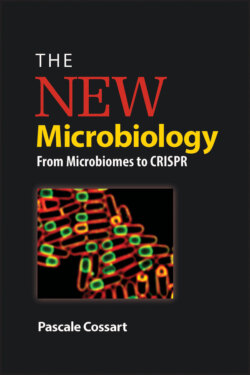Читать книгу The New Microbiology - Pascale Cossart - Страница 15
Riboswitches: molecular interrupters
ОглавлениеSome noncoding RNA elements, called riboswitches, function as interrupters. Situated at the beginning of certain mRNAs, a riboswitch can fold in two different ways depending on its binding to its specific ligand. If the riboswitch binds to a ligand, its RNA can take on a form that either impedes the translation of the mRNA (translational riboswitch)—in which case the entire mRNA is synthesized but its message is silenced—or stops the transcription of the genes downstream of it (transcriptional riboswitch), which leads to the synthesis of a very short RNA. If the riboswitch does not bind to the ligand, the RNA is transcribed in its entirety and is also completely translated. These riboswitch ligands vary greatly in nature, from S-adenosylmethionine (SAM) to vitamin B1 or B12 to transfer RNA or metals such as magnesium.
Riboswitches not only regulate mRNAs as explained above, they can also regulate noncoding RNA. There is such a case in the foodborne pathogen Listeria monocytogenes, in which a vitamin B12 riboswitch controls an antisense noncoding RNA for the regulator of a series of genes. These genes encode enzymes that process propanediol, a compound present in the intestine that is produced by the fermentation of certain sugars by commensal bacteria. These enzymes require vitamin B12 to function as follows: (i) in the presence of B12, the riboswitch leads to the synthesis of a short RNA while allowing synthesis of the regulator protein PocR, and PocR then activates the synthesis of genes under its control; (ii) in the absence of vitamin B12, the riboswitch is configured such that a long form of antisense noncoding RNA is produced, which hybridizes to the mRNA that codes for PocR, stopping its production. Thus the PocR activator is not produced unless conditions are favorable, that is, if proteins encoded by the genes that it regulates can be activated by vitamin B12.
Figure 7. Schematic representation of the chromosome region encoding PocR. In the absence of vitamin B12 (left), the long transcript AspocR hybridizes with the transcript for pocR, which is then destroyed, preventing the synthesis of PocR. In the presence of B12, the pocR messenger RNA allows synthesis of the protein PocR.
Another example of a nonclassical riboswitch is a different vitamin B12 riboswitch found in L. monocytogenes and Enterococcus faecalis, both of which cause intestinal infections. This riboswitch controls a noncoding RNA that can sequester a regulator protein that activates the eut genes. eut genes code for proteins involved in the utilization of ethanolamine, a compound found in abundance in the intestine. The riboswitch works as follows: (i) if vitamin B12 is present, a short form of RNA is produced, a form that does not sequester the regulator protein, which is then free to activate the expression of the eut genes; (ii) if vitamin B12 is absent, a long form of noncoding RNA is produced that sequesters the regulator protein, which is thus unable to activate the eut genes.
This complex alternative process is crucial to the survival of pathogenic intestinal bacteria. Pathogens can use ethanolamine, but only when vitamin B12 is present. Since eut genes are not present in commensal bacteria, they provide pathogens a significant advantage over commensal bacteria.
